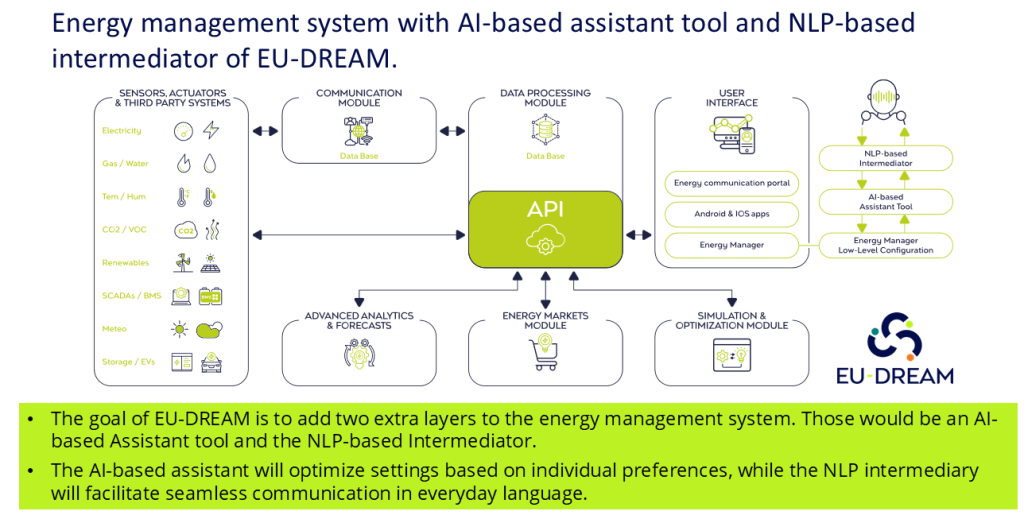Insights from EU-DREAM’s first webinar
In a dynamic and thought-provoking webinar held in June 17th 2025, four experts from across Europe gathered to explore the intersection of Artifical Intelligence (AI), citizen engagement, and the energy transition. The session, titled “AI Can Talk – But Can It Listen to Citizens?” brought together researchers, engineers, and community enablers to discuss how digital tools can empower individuals and communities to take an active role in shaping their energy futures.
Understanding the Engagement Gap
Irina Rets, Senior Research Fellow at Open University, opened the session by presenting findings from the Every1 project, which examined demographic differences in energy literacy and interest. “Interest in learning about energy increases with educational attainment,” she noted, highlighting that 42% of doctorate holders expressed strong interest, compared to just 10% of those with basic schooling. Gender, income, and housing status also played significant roles in shaping engagement.
During her intervention, Rets emphasized the importance of agency and access: “People wanted to know how affordable, efficient, and user-friendly today’s photovoltaic systems are.” She added that many respondents, especially renters, felt disempowered: “They felt they lacked the agency to make changes.”
Despite these barriers, she highlighted a strong appetite for collaboration. “One respondent said, ‘I want to learn how to create an energy neighborhood.’ That kind of curiosity shows a real appetite for community-based approaches,” Rets concluded.
- Download Every1’s report here.
- Read the Energising the Energy Literacy Debate for Environmental Education: Exploring Citizens’ Interest Levels, Knowledge Gaps and Individual Differences article here.
AI as a Bridge to Participation
The conversation then shifted to the EU-Dream project, with Marialaura Di Somma, Associate Professor, Team Leader & Project ManagerUniversity of Naples Federico II, and Gianfranco Chicco, Full Professor of Electrical Energy Systems Politecnico di Torino, Polito, presenting their research on how AI can support citizen participation in energy systems.
“We’ve found a significant gap between the aspirations of the energy transition and the lived experiences of everyday consumers,” said Di Somma. She explained that AI can act as a “smart intermediary,” translating complex energy data into actionable insights. “Citizens don’t need to understand every technical detail… they need to understand how their preferences and routines impact energy use.”

Based on the responses from a survey led by EU-Dream, Chicco added that while awareness of smart appliances is growing, understanding of AI remains limited. “The highest percentage of respondents weren’t sure if their appliances had AI-based control functions,” he said. He also noted a generational divide: “The youngest age group showed the lowest awareness of smart appliances… likely because they don’t use household appliances as frequently.”
Despite these gaps, there is optimism. “A significant portion of respondents were willing to pay up to 10–20% more for improved appliances,” Chicco shared, though he cautioned that few were willing to pay more than 50% above current costs.
Tools for Social Innovation
Jurijs Grizans, Senior Expert in Sustainable Energy Systems at the ICLEI – Local Governments for Sustainability, emphasized the importance of social innovation and community-driven tools. “The Enpower project is truly about putting power in people’s hands,” he said. The project’s digital playbook offers tools like the Citizen Renewable Platform for social engagement and the Interactive Decision Support Tool for Energy Community Planning, designed to help citizens form and manage energy communities.
“These tools are open and available to all interested stakeholders,” Grizans explained. “They include gamification, intuitive design, and GIS integration to make them more user-friendly.”
He also introduced the project’s 4D model—Decentralization, Decarbonization, Democratization, and Digitalization—as a framework for building inclusive, citizen-centric energy systems. “We’re working to create opportunities through a digital engagement platform that supports these needs,” he said.
- Download Enpower tools here.
Addressing Environmental Concerns
During the Q&A, an audience member raised concerns about the environmental impact of AI. Di Somma responded that EU-Dream’s tools are designed with sustainability in mind: “These tools aim to maximize flexibility provision by end users, which can help reduce curtailment of renewable resources and lower peak energy demand.”
Chicco added a broader perspective: “AI requires high-powered infrastructure and energy-intensive data centers… Instead of relying on large, general-purpose models, we could develop dedicated, domain-specific AI systems that are more efficient.”
The Need for Interdisciplinary Collaboration
The session closed with a reflection on the growing need for interdisciplinary collaboration. “Most energy studies are purely technical, with very few truly interdisciplinary efforts,” Rets observed. “Just like with climate change, we need collaboration not only across communities but across disciplines.”
Grizans echoed this sentiment, emphasizing the importance of energy literacy: “Digital tools shouldn’t just visualize things like energy payments… they should also help people make sense of energy in their daily lives.”
Final Takeaways
Moderator Gabriella Siegfried, Senior Sustainability Analyst at the Electric Power Research Institute (EPRI), summarized the session with three key insights:
- Bridging the Engagement Gap: “Understanding demographic data and how it relates to engagement is crucial… especially among underrepresented groups.”
- AI as an Enabler, Not a Replacement: “AI can help individuals reduce energy consumption and save money… but it’s a complement, not a substitute, for meaningful citizen participation.”
- The Role of Social Innovation: “For digital tools to succeed, we need social innovation… especially in hard-to-reach communities.”
The webinar concluded with a call to action: to continue building tools, partnerships, and policies that empower citizens—not just as consumers, but as active participants in the energy transition.
Webinar recording
Did you missed the webinar? Watch the full recording below.
